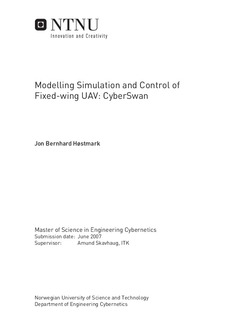| dc.description.abstract | This report treats modelling, simulation and control of a fixed-wing aircraft, including implementation of a Aircraft Flight Control System (AFCS). The design and construction of a suitable airframe (design og konstruksjon av ubemannet fly for visuell overvåkning) by Jon Bernhard Hsøtmark is continued in this work. This system was designed to be suitable for surveillance purposes, using electrical propulsion and being low cost. Preferable characteristics considering stability and control to ease control, implementation and tuning of controllers were built into the airframe. The work done here confirms that the goal in cite{bib:bernhard} was met, and compleating the autonomous system using feedback regulation.newline The work finished this spring were divided in to three reports. Design and implementation of sensor and computer system for fixed-wing UAV, by Edgar Bjørntvedt Modelling, simulation and control of fixed-wing UAV, Jon Bernhard Høstmark Ground Station and hardware peripherals for fixed-wing UAV, Mikael K. Eriksen Each task was assigned to one person. This report includes the work done with respect to modeling, simulation, control and testflights. The main focus was building a working prototype. In addition to the technical work, the author of this report has ensured that the project stayed on track. The conclusion in the end of the report discuss this further. June 2007 the three subsystems was integrated for flight testing. Video supplied with this work show stable autonomous flight confirming a working AFCS. Having a working system is thought to be of great value for further work. The working system can also be used for verifying the analytical models obtained thought this work. Adding more sensors to the computer system enable further and tighter controllers, such as height control and waypoint navigation. With these features the UAV system should be ready for surveillance purposes in the commercial market. | nb_NO |

